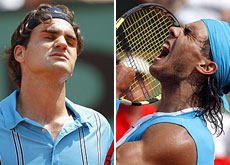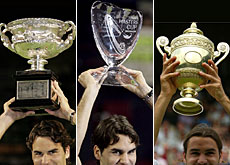Federer falls at final Grand Slam hurdle

Swiss world tennis number one Roger Federer has been beaten by defending champion Rafael Nadal 3-6, 6-4, 3-6, 4-6 in the final of the French Open.
The top-seeded Swiss – who lost to Nadal in the semifinals in 2005 and in the final last year – sought to become only the second man in the open era (post-1968) to win a fourth consecutive major title, the Grand Slam.
With a sequence of brilliant shots, Federer won many of the best rallies, but he was let down by inconsistency and his inability to win important points. He failed to convert his first 11 breakpoint chances, putting pressure on his own serve by repeatedly allowing Nadal to hold.
Nadal saved 16 of 17 break points and broke serve four times in ten chances. He committed only 28 unforced errors to Federer’s 60. Even a player of Federer’s calibre can’t hope to beat Nadal – who has never lost in the French Open – when giving away points like that.
Rooting for history, the crowd was pro-Federer, but when Federer’s final shot landed long, fans roared for Nadal as he collapsed on his back.
For Federer, the story was all too familiar: since the beginning of 2005, he’s 4-7 against Nadal – winning four matches and losing seven – and 199-7 against everyone else. His record against Nadal on clay is now 1-6.
The second-seeded Nadal made a little history of his own, becoming the second man since 1914 to win the tournament three consecutive times and the first since Björn Borg in 1978-81. Still only 21, Nadal improved to 21-0 at Roland Garros and 34-0 in best-of-five-set matches on clay.
Dispirited
On the warmest day of the tournament, spectators were fanning themselves from the outset and both players began to look weary in the pivotal third set. But the dogged Nadal kept chasing down shots, sprinting after one dropshot and flicking a winner after nearly three hours on court.
Nadal relentlessly probed his opponent’s allegedly weaker side, sometimes forcing Federer to hit half a dozen backhands in a rally. But Federer’s usually formidable forehand may have hurt him more – the shot misfired several times on potential putaways and sent them sailing long.
Federer repeatedly had chances to take command. In the first set, Nadal fell behind on his serve 15-40 twice and 0-40 once, but each time the Spaniard rallied to hold.
Federer took a 3-2 lead but became dispirited when he failed to convert five break points in the next game, and Nadal won five consecutive games.
Federer broke for the only time to go ahead 4-3 in the second set. Even then he needed five set-point opportunities before he closed out the set to pull even.
It was the only set Nadal lost in the tournament, and he bounced back quickly, breaking in the second game of the third set en route to a 3-0 lead. Nadal broke again for a 2-1 lead in the fourth set when Federer dumped a weary backhand in the net, and the Spaniard never wavered from there.
In the final two sets, Nadal faced only one breakpoint, saving it with a big forehand.
He won €1 million (SFr1.66 million), while Federer received $670,000 – small consolation for a player who has dominated the other major events, winning Wimbledon four times and the US Open and Australian Open three times each, all since 2003.
Federer had acknowledged before the match that winning the Grand Slam “would boost my career in an incredible way”.
That boost is going to have to wait at least another year.
swissinfo, Thomas Stephens with agencies
A player who holds all four grand slam titles – the Australian Open, the French Open, Wimbledon and the US Open – at the same time is said to have achieved the Grand Slam. A “true” Grand Slam is when all titles are won in the same calendar year.
Rod Laver is the only male player in the open era (post-1968) to achieve a Grand Slam (which was also “true”), in 1969. Andre Agassi won all four titles but in different years (a career Grand Slam).
Grand slam titles (open era):
14: Pete Sampras
11: Björn Borg
10: Roger Federer
8: Andre Agassi, Jimmy Connors, Ivan Lendl

In compliance with the JTI standards
More: SWI swissinfo.ch certified by the Journalism Trust Initiative












You can find an overview of ongoing debates with our journalists here . Please join us!
If you want to start a conversation about a topic raised in this article or want to report factual errors, email us at english@swissinfo.ch.